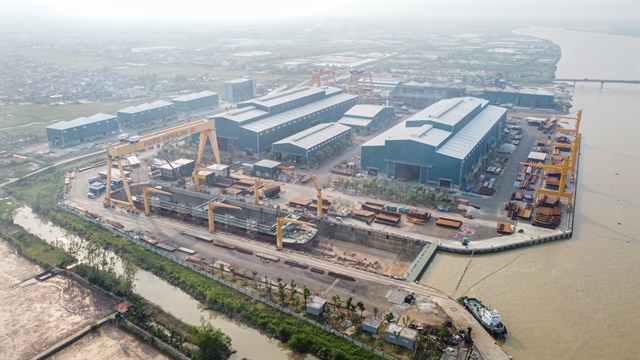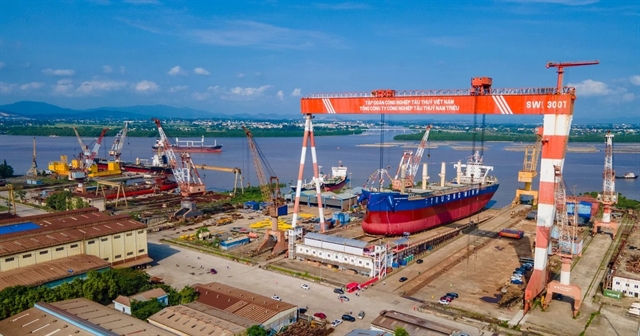Việt Nam's shipbuiding industry aims to capture 0.8 per cent to 0.9 per cent of global output by 2030, focusing on general cargo ships of up to 70,000 tonnes, container ships, LPG carriers, and other service vessels. Domestically, the industry is tasked with meeting the need to renew and expand the national fleet.

HÀ NỘI — Việt Nam is setting its sights on strengthening shipbuilding by maximising the use of existing infrastructure and capitalising on its strategic geographical location, according to a new development plan.
The initiative is part of a broader project aimed at enhancing the capacity of domestic shipbuilding enterprises through 2030, with a long-term vision extending to 2050. The proposal has been submitted to the Prime Minister for approval, baodautu.vn reported.
The project builds upon prior planning efforts and is consistent with the policy on restructuring the Shipbuilding Industry Corporation (SBIC). It also aligns with strategies for sustainable marine economic development through 2045 and industrial development through 2035, the online newspaper cited Deputy Minister of Construction Nguyễn Xuân Sang as saying.
A key highlight of the plan is its detailed and phased targets for the shipbuilding industry over the next five to 10 years. By 2030, the SBIC restructuring project is expected to be largely completed, with formerly affiliated enterprises stabilising operations, rebuilding their brands and improving profitability and management capacity.
It also recommends allocating funding and implementing supportive mechanisms to enable defence industrial enterprises to participate in auctions or directly receive key SBIC shipyards located in areas critical to national defence and security, such as Cam Ranh, Hạ Long and Sông Hồng.
An SBIC representative emphasised the importance of drawing up a suitable support policy for domestic enterprises to receive and inherit facilities, assets and human resources from SBIC after bankruptcy.
That would certainly make the most of existing resources, limit the waste of assets, and at the same time maintain the important technical infrastructure foundation for the shipbuilding industry to grow stronger in the next five to 10 years, the representative said.
Clear targets for development
As per the project, Việt Nam's shipbuiding industry aims to capture 0.8 per cent to 0.9 per cent of global output by 2030, focusing on general cargo ships of up to 70,000 tonnes, container ships, LPG carriers and other service vessels. Domestically, the industry is tasked with meeting the need to renew and expand the national fleet.
On the export front, the goal is to produce one million tonnes of vessels for international markets, about 30 per cent of total new output.
Looking further ahead, the project aims to increase the localisation rate of shipbuilding products to 30-40 per cent by 2040, including 10 per cent in materials and equipment, boosting Việt Nam’s share of global shipbuilding output to 1 per cent.
By 2050, the localisation rate is projected to surpass 50 per cent, with 20 per cent in materials and equipment, and the industry is targeting to account for 2 per cent of global shipbuilding output.
As global and domestic demand for new vessels steadily increases, experts say Việt Nam’s shipbuilding industry is well-positioned for significant growth. Currently ranked seventh in the world, Việt Nam holds a 0.61 per cent share of the global shipbuilding market, surpassing established shipbuilders like Finland, which held 0.36 per cent.
With an annual domestic shipbuilding capacity of around 3.5 million tonnes, the country has both the industrial base and strategic geographic advantages to expand its presence on the international stage.

Industry snapshot: opportunities and challenges
Việt Nam currently has 88 shipbuilding enterprises and 411 inland waterway vessel production facilities. About 120 of these specialise in building and repairing vessels over 1,000 tonnes. The country’s total capacity for new cargo ship construction is approximately 3.5 million tonnes per year, including vessels over 5,000 DWT.
Beyond commercial ships, Việt Nam also produces tugboats, patrol boats, rescue ships, high-speed aluminum-hull vessels, and service ships for both domestic and export markets. With a current global market share of 0.61 per cent, Việt Nam ranks seventh in the world in shipbuilding.
However, challenges remain. The industry is under pressure to adapt to green energy transitions and carbon reduction mandates, insiders said.
Many shipyards lack the infrastructure and capital to produce environmentally friendly vessels, and there is a notable absence of tax incentives or financial support policies to facilitate this transformation.
They added that much of the shipbuilding sector has developed through basic assembly and processing, which limits its ability to create high-value products. Many shipyards operate with outdated infrastructure and technology, undermining their international competitiveness.
A lack of investment in technological upgrades and ship design capabilities has hindered the development of prototype vessels tailored to market demands. These constraints pose a major obstacle to Việt Nam's ambitions to move up the value chain and capture a larger share of the global shipbuilding market.
According to Hoàng Long, head of the Việt Nam Maritime Corporation's Transport Department, the shipbuilding industry is recognised as a priority sector for investment, with various tax and land-use incentives already outlined in national regulations.
Looking ahead, he emphasised the need to revisit and refine existing policies to better align with broader economic development strategies and maritime growth objectives. — VNS





